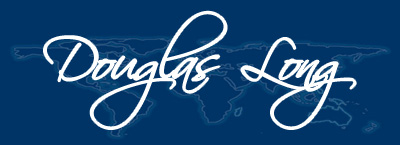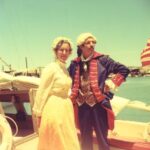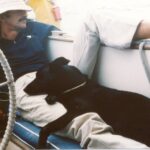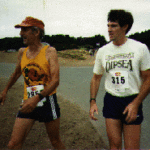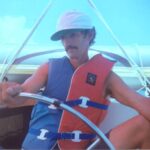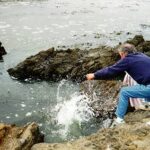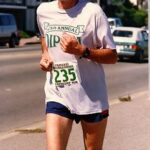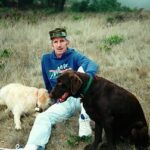Dad
His childhood family and friends knew Al Long as Kayo, but I knew him, as Dad, the one and only that I will ever have. As I watch him these last days, he was a shadow of the man he used to be, but like a mountain, he casts a big shadow.
He was born in 1931, a child of the depression, in Cleveland, Ohio. His father, Adelbert, worked for Ford Motor Company and earned a Masters in Public Administration. Right after Pearl Harbor, he received a direct commission in the grade of First Lieutenant, Adjutant Generals Corps, United States Army. He moved the family to the Washington DC area. During the war, he served in the Pentagon as a manpower specialist. After the war, he continued his service in the Army Reserve, with annual periodic training, and retired from the Army as a Lieutenant Colonel. His civilian job, while serving in the Army Reserve, was in the Department of Labor and then chief of staff for the work-in-training program of the Department of Health, Education and Welfare.
Dad’s youth was spent in suburban Greenbelt, Maryland. He had an older sister, Nancy, and younger siblings Rosemary, Stuart, Joe, Tricia, Michelle and Richard, spanning 24 years of age. Dad’s mother, Patricia Quigley, was a very intelligent woman and was very active in Greenbelt women’s affairs. She was also very active in the Catholic Church in Greenbelt. She was born in Rothesay, Isle of Butte, Scotland.
As a youth, Dad was known to be mischievous and playful with a love to travel. His siblings went on to college, but Dad was not so keen on sitting in classrooms. After graduating from Greenbelt High School he joined the Navy, which sent him to Treasure Island, San Francisco. His Naval career was cut short by an epileptic-like seizure, but the visit to California would later change the course of his life. Ironically, it seems that the seizure was nothing more than a reaction to a bump on the head he incurred from getting towed by a horse on a bicycle.
After the Navy, he worked as a merchant marine seaman, sailing around the world for eleven years. He would disappear for months, returning to the family who has now moved to Chevy Chase, Maryland. Every time he returned it was a bit like Santa’s visit, with a bag of exotic treats from distant lands.
His voyages took him to almost every major port in the world, and the stories he would later share were the stuff of dreams. During the Cuban Missile Crisis, he was on a tanker coming from Europe to Texas. U.S. Naval ships would challenge the ship at several points as they skirted the Caribbean. He crewed on one of the most famous ships in the history of transport, the Ideal X. This was the first-ever intermodal ship, an experiment that moved truck trailers between Texas and New Jersey. The Ideal X proved that intermodalism worked, and the transportation industry was never the same again.
You can tell a lot about a person by his father. The same is true in this case. My grandfather did not look kindly on my father’s career. When Dad came home from his trips they sometimes got into shouting matches with each other. Unfortunately, my Dad picked up the same habit when he became a father, but at the same time, he was still the fun-loving adventurer.
In 1962, he crashed a party and met the woman of his dreams. The Congressmen’s wives would put on a party for young, single members of the diplomatic corps. Joan Webster was working for the British embassy, decoding messages for NATO. She came from St Helens, England, an industrial city not known for anything in particular except pollution and Pilkington Glass. Her life was not easy, with memories of carrying a gas mask to school, and life in a crowded row-house in post-WWII. After high school she worked for a U.S Air Force base in Warrington, England for a short while before joining the British Foreign Service.
Mom was hanging out with a Christian group, and heard that Soviets were going to the Congressmen’s parties preaching atheism. She decided to show up at the party one day to confront them. She didn’t find any Soviet atheists, but she did meet a sailor who had crashed the party, and the rest is history.
Dad had returned from one trip with a Japanese wife, not something that the family appreciated, and nobody was grieving when that marriage soon ended. Joan, on the other hand, was kind of lady that parents-in-law dream of, and she would succeed in ending Dad’s wandering life. She returned to England and he later took the Queen Mary back to England where they were married on June 22, 1963.
They lived in Greenwhich Village, New York, which both remembered with fond memories. Dad completed an electrician’s license program. Returning to Chevy Chase, they had a son, Andrew. Dad was working at an industrial bakery while Mom stayed home and raised her child. I was born a little over a year later, in 1965.
A year after I was born, Dad and Mom moved to California. It has always fascinated me why people decide to move across the country to unfamiliar lands, but I’m not complaining. They first lived in Pacifica, a foggy town along the coast just south of San Francisco. Dad started work at another bakery as an engineer, a career which he would stick with, with a few detours, for the rest of his working life. He asked at work one day what was a good area to live in, and someone mentioned Marin County, on the northern side of the Golden Gate Bridge.
They bought a house, 112 Lehman Lane, Mill Valley, and this where my earliest memories began. It was a modest house, but the area would soon boom. Thousands of other World War II veterans had seen San Francisco on their way to the Pacific theater, and many would move to the City by the Bay. Marin County was a beautiful, quiet suburb in the shadow of Mt Tamalpais (Indian for ‘Sleeping Lady’). Marin would become the second richest county in the nation, which was odd because we were far from wealthy. Mom once said that life was rough, but if that was the case, they did their best not to make their children aware of it. I have the fondest of memories growing up in this small town.
Dad worked hard on the night shift, but he needed to make ends meet, so he also started other jobs. For a couple years he was a Mac Tools dealer. I recall when he got a shipment of tools for inventory. It was like Christmas opening up boxes and boxes of strange tools without any clue what they did. One tool stands out, a wrench that was so huge it made me wonder how someone could even pick it up no less use it. Being an independent salesperson had some benefits. He would get to know every mechanic in the county. But it also could be frustrating. I recall joining him in Small Claims Court trying to get someone to pay his bills. The person never was able to pay, but we did end up with a bicycle, not that that was worth much.
He also worked for Grange Debris, driving a truck picking up and delivering debris boxes. This was a boy’s dream, big tucks and garbage. He would take me with him sometimes, but he kept having to tell me to stay out of the garbage, no matter how interesting was the stuff people threw out. He even let me run the controls picking up a box. One day he was having a tough day, lost a chain used for securing the box, and a couple other things. I just remember feeling bad because he was trying so hard, but we all have those kind of days sometimes.
Life was not always easy, though. Mom got breast cancer, leaving her scarred physically and emotionally. Seeing what she was going through was one of the most painful experiences of that time. This was a time when the medical technology was not as good, so the recovery was not so smooth, and a woman’s concept of herself was more tied up with her body. She was far from her family in England, which would always be a problem.
One day he saw an ad for sailing lessons, given by a local sailor named Jack Benjamin. Dad was soon hooked. He bought a Islander 21, but this was soon replaced with a Cornado 25. He joined the Sausalito Cruising Club and raced on the bay. One year he was in the National Championships and placed 11th. It seemed like all our spare time was spent in Sausalito and other boat places. He would also do overnighter races, and it was a family affair. I loved camping out in the boat, but the bay is a mighty cold, wet place.
The family outgrew Mill Valley for a variety of reasons. The house was small and Andrew and I were getting bigger. The town was very damp, aggravating Mom’s allergies. The schools were also liberal, in a strange way, without discipline or structure. So they moved north a few towns over, to San Rafael.
The house, in which I am writing this, 99 Marina Court, looks small from the front, but it is actually quite roomy, with three bedrooms, all on one level, on a hillside looking out on San Pablo Bay (a part of the San Francisco Bay system). It was owned by Mrs. East, who had lived here for decades. With the money from the sale of 112 Lehman Lane, we had some extra cash, and 22 Marina Court also came on the market. They bought that, so now we had two houses a block apart. One day we moved from 99 to 22. At the end of a long day of hauling boxes and furniture, we sat down to rest. All of a sudden, Mom breaks out crying. She missed the first house. So the next day we moved back.
Dad has a spark of adventure, which in my opinion is the single greatest thing he brings to life, and his greatest adventure was about to unfold. He proposed to pack up our belongings and live on a boat in the Caribbean. Maybe we would cross the ocean to Europe, maybe go through the Panama Canal. I hated the idea of leaving my town and friends. Never one to let destiny hold us back, we packed up and moved to Ft Lauderdale, Florida where we bought a Rasmus 35, a 35-foot long Swedish built sloop, and began a year-long trip throughout the Caribbean. Life on the boat took a little getting used to, with two boys and our dog Mickey. One day Mom was hand-pumping water for the morning coffee when she suddenly went a little wild and took her frustrations out on the pump. At least we got a lot of water pumped real fast. In the end we all adjusted and it was the voyage of a lifetime.
Starting in Ft Lauderdale, we went through the Abaco Islands in the Bahamas for a couple weeks. This was the shakedown trip, and we returned to Miami, well shaken down. After a little more preparation, we headed south, through the Bahamas, Haiti, Dominican Republic, Puerto Rico and the Virgin Islands. Never before had I seen crystal clear blue water teaming with tropical fish and dolphins jumping on our bow waves.
Haiti was a different world, where people could be friendly and helpful in the face of desperate poverty. A woman lay dead on the roadside, waiting for the garbage pickup. We visited Cap Hatian, on the north coast, home of the famous Citadel. This visit made me aware of the suffering and poverty that others face, an experience which would affect me forever. Dad had seen all of this before, but he was introducing us to things that most kids will never see.
We motored up the intercoastal waterway from Florida to Annapolis, where we sat for a couple months, unable to sell the boat. Finally we put it on a truck, and drove across country to resume life in San Rafael. Now we were living in 22 Marina Court, renting out 99. Andrew and I started high school while Dad went back to work at a bakery. Mom began working as a secretary at the psychiatric ward of San Quentin Prison, an interesting career in which she got to meet some of the most infamous criminals in California.
This was also a rough period, because Andrew and I were now in our teens. Dad was always the King of his castle, and teenagers don’t fit well into that picture. In 1982 we moved back to 99 and sold off 22. At the same time, Dad and Mom started an antique business. They would buy up antiques at auction, and even made a couple trips to Europe buying furniture, selling it in a few different outlets in the county. It was a lot of fun, but didn’t make any money. After a couple years Dad went back to work in a bakery.
Andrew and I posed a special challenge for Dad during our teenage years. Andrew came out of the closet and announced that he was gay, to which Dad responded by kicking him out of the house. This was not to say he didn’t love Andrew, but there was conflicting emotions between his conservative Catholic upbringing and the morals of a new generation. While kicking Andrew out of the house, he then set him up in an apartment 5 minutes away, then proceeded to hang out with Andrew in his new pad.
I challenged Dad in a different way, by following his wandering way. At the age of 15 I wanted to bicycle across country, which is about as brilliantly stupid as packing up a family and living on a boat. Dad would have none of it, but the next year I prepared to do it whether he like it or not. He relented, but only because he didn’t think I would get out of the state before calling home to be picked up. As it turned out, the bike ride took me 32 days to get from here to Washington DC, and everyone’s reaction was, basically, “this is the sort of thing you can expect from Kayo’s boys”.
Dad continued working at the bakery, Mom continued at the prison, and Andrew and I were in college (UCLA and UC Berkeley, respectively). I graduated and went into the Army, eventually stationed at Schofield Barracks, Hawaii. This is when near-tragedy struck. Andrew’s heart was infected, and he came to within a hair’s breadth of dying when the doctor’s discovered it, and he went in for an emergency valve replacement. Occasions like this have a silver lining, because when I arrived from Hawaii, Dad was sitting in the same room with Andrew and his partner at that time, Dave. To see Dad next to his gay son’s partner was quite an event. Andrew would go on to heal and live a normal life, and while Dad was never at ease with his son’s orientation, he learned that even one’s child is an independent person and you need to let them live their life on their terms.
The two years that I was in Hawaii was also a period to reflect on Dad as my father, and his new role as my friend. It takes a lot of time and distance sometimes, but the changes let me see him in a whole new light. I started to think about what he was like at that age, also wandering the world. The stories that he told us about his early years were no longer just stories. It was as if I were reliving his life in some ways.
Around this time Dad make some dramatic changes, stopping smoking and beginning to run. It seemed a little odd to think of my father as a runner, but he had the physique, and of course the passion for movement. He started running short races, and while he was never fast, it was a new joy and something he could share with Mom. To see them both taking on running in their 50’s was quite a treat. Dad did a marathon, which would be followed by at least 10 others, including the famous Quadruple Dipsea and the London Marathon. He and Mom were active in the Dolphin South-End Runners Club and the Tamalpas.
He and I would run together, doing the San Francisco Marathon together. We ran almost in step for 26 miles. One time he ran alongside me for 10 miles as I did the California International Marathon. It may seem strange to non-athletes, but running and exhaustion brings your emotions to the surface unlike anything else. There wasn’t anything particularly special about this one race, but when he pulled out just before the finish (since he wasn’t registered and hadn’t done the whole course), I started to cry a little because of the bond between us. Guess you have to run 26 miles to understand.
The Dipsea Race plays a special role in our family. It is the Sunday around his birthday, so the after-race picnic always served as his party. This is a famous race because it is one of the oldest in the nation, run across any route one chooses from Mill Valley over Mt Tamalpais to Stinson Beach. It was handicapped by age and sex, so Dad would get a 22-minute lead on me. This meant that we were looking at how fast we were adjusted for our age differences. And the result? Only one year was I ever able to beat him. Mom would also do the race, noted for her shirt that we had specially made, saying “Don’t Push Mama from the Trail”, a spoof of the movie “Don’t Push Mama from the Train”.
After returning from the Army, I would travel for a year, eventually returning to San Rafael to graduate school, marry and go to work in an office. I was lost, not interested in any of the career options that presented itself, especially doing what he did as a stationary engineer. Yet we shared the same frustration, making a living and being a responsible family member when we yearned to travel.
He started to do volunteer work at the Marine Mammal Center, caring for injured seals. He would go a couple days a week cleaning, feeding and medicating all of the seals that would show up on California beaches with propeller cuts, gunshot wounds, shark bites or disease.
As the years wore on, he retired from his work at the bakery. It’s funny how you can retire and be busier than before. He volunteered rehabilitating historic ships in Sausalito, and put in a lot of time with the Marine Mammal Center. He loved to work on the house, maybe a bit too much. The house has a mother-in law unit that he rents out to students from Dominican College. Every time the apartment turns over, it gets remodeled. He and Mom bought a camper, planning to spend their golden years driving around America. Actually this thing was a lemon, and every trip included some story of breaking down or breaking something.
Older people are often afraid of computers, but then again some discover their benefits and become addicts. Dad was the latter. One day he started playing around with older model PC. Before we know it, he was on AOL discovering the Internet. He established new contacts with friends and family. Mom did not like this, as he was spending hours either surfing the Net or playing games. As far and Andrew and I were concerned, he’s retired, and he can do what he pleases.
In the summer of 2000 he started to feel tired, which at first he discounted as age. Then it seemed that the fatigue was more than normal, so he went to see a doctor. This was the beginning of the end, which would move faster than I ever imagined. The doctor said it was anemia, but it could be caused by any one of many causes. Further tests would need to be done.
At this time I was in Moscow, doing a professional internship with the a freight forwarer. Dad was normally on the computer all the time, but his silence did not go unnoticed. Midway through my trip, Andrew came out to join me for the last couple weeks. We went from the airport to a McDonalds, where he told me the news. Dad was diagnosed with a pre-leukemia condition that gave him 1 to 3 years to live. I held myself together but that night I was having nightmares.
There was one hope, a stem-cell transplant, but at his age the only place that did that was the National Health Institute in Washington DC, as an experimental program. It was later discovered that Stanford also did the same procedure. Still, this was a risky operation, with a roughly 40-60% survival rate, and months of painful treatment. Dad’s life was at stake, so we pushed ahead. His brother Richard and sister Nancy were identified as good donors.
His health did not hold out. While Andrew and I were in Moscow, he contracted pneumonia and was in intensive care for 16 days. He insisted that we not be notified, so Andrew and I never new how close he was to death. In the ensuing months, he got weaker, but still hoped for the transplant that would keep him going.
One day we were sitting in Double Rainbow Ice Cream in downtown San Rafael, one of our favorites, sitting at the window, when he said something that I will never forget. He said “You know, I though I had 15 or so years left, but guess that’s not the way it’s going to work out”. Suddenly I realized that the father that was my foundation, my anchor, was not going to be around forever.
His health continued to deteriorate; yet, he still held hopes of Stanford. In November he returned to Washington DC to attend his brother Joe’s wedding. This was his chance to see the entire family and visit all the sites of his youth. It was to be the trip of a lifetime. As his body faded, he kept up a strong façade. Never one to admit weakness, he told the family that all was well, when in fact that was the furthest from the truth.
I was amazed to see how he changed, first on a daily basis, and even then on an hourly basis. He tried desperately to continue to drive, but one day he grabbed the keys and as we walked to the car, I took them from him. He protested, then silence. One of his prerogatives was always to drive, and now he even lost this. Illness is hardest on the ego, but I had to remind him that he had done more than his fare share of carrying the family. Now it was our turn to carry him. One day the doctors gave up and admitted that they didn’t know why he was getting weaker, so they could either take heroic measures, or he could accept it. He chose to accept it.
On January 13, Mom and I were sleeping on the couches in the living room, with Dad in his hospital bed in between us. While the night was spent fading in and out of sleep, I looked over at him as he took a breath, and fell still. That was the peaceful conclusion of a long and storied life, ended in his home surrounded by those who loved him.
He was cremated, with half the ashes in a grave at Daphne in Mill Valley, CA. The other half was spread near Lone Tree, a landmark midway on the Dipsea Trail that we all enjoyed so much.
